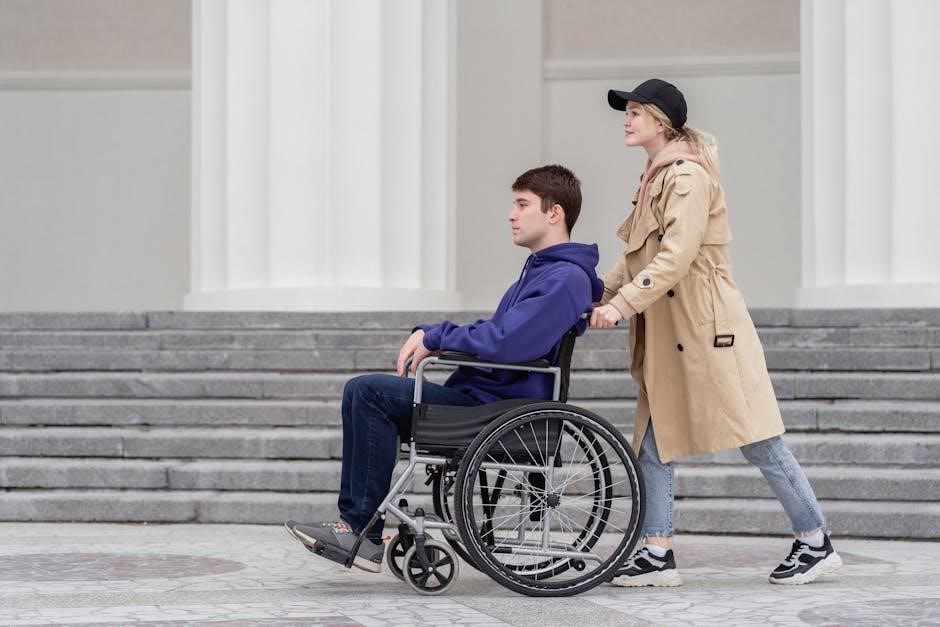Manual standing wheelchairs empower users with independence, enabling them to stand and move, promoting physical health, confidence, and a more active lifestyle in various environments daily.
Definition and Purpose
A manual standing wheelchair is a non-motorized mobility aid designed to support individuals with physical disabilities. Its primary purpose is to enable users to stand upright and move independently, promoting better posture, muscle strength, and circulation. It combines the functionality of a wheelchair with the ability to stand, offering enhanced mobility and independence for daily activities and rehabilitation.
History and Evolution
The concept of manual standing wheelchairs emerged in the mid-20th century, evolving from early mobility aids. Initial designs were rudimentary, focusing on basic functionality. Advances in materials and technology in the 1980s and 1990s led to more sophisticated models, prioritizing user comfort and mobility. Today, these wheelchairs integrate ergonomic designs and innovative features, enhancing independence and rehabilitation outcomes significantly over the years.

What is a Manual Standing Wheelchair?
A manual standing wheelchair is a mobility aid designed to empower users to stand and move independently, promoting confidence and freedom in daily activities.
Key Features and Components
Manual standing wheelchairs feature durable frames, adjustable seating, and mechanisms to transition between sitting and standing. They include lightweight materials, ergonomic designs, and secure harnesses for safety. Customizable settings allow users to tailor fit and functionality, while robust wheels ensure smooth mobility both indoors and outdoors, enhancing independence and ease of use.
How It Works
Manual standing wheelchairs operate through a mechanism that allows users to transition between sitting and standing. Users shift their weight or use levers to activate the standing function, supported by sturdy frames and harnesses. This process enhances mobility, promotes upright posture, and enables greater interaction with surroundings, providing both convenience and independence for daily activities.

Benefits of Using a Manual Standing Wheelchair
Manual standing wheelchairs enhance mobility, independence, and physical health by allowing users to stand, improving posture, strength, and confidence while promoting emotional well-being and social engagement.
Physical Health Benefits
Manual standing wheelchairs offer significant physical health benefits by enabling users to stand, which enhances muscle strength, improves posture, and reduces the risk of pressure sores. Standing also promotes better circulation, strengthens bones, and improves respiratory function. These features collectively support overall physical well-being and help prevent long-term health complications associated with prolonged sitting.
Emotional and Psychological Benefits
Manual standing wheelchairs foster emotional well-being by empowering users with independence and confidence. Standing upright enhances self-esteem, reduces feelings of limitation, and promotes a sense of equality in social interactions. This ability to engage fully in daily activities can alleviate depression, improve mental health, and create a stronger connection to one’s surroundings and community.

Types of Manual Standing Wheelchairs
Manual standing wheelchairs come in folding and rigid models, offering portability and durability. They cater to various needs, ensuring users can stand and move with ease and stability.
Folding Models
Folding models of manual standing wheelchairs are designed for portability and ease of use. Lightweight and compact, they are easy to transport, making them ideal for users who need a convenient mobility solution. These models often feature adjustable frames and customizable settings to accommodate different user needs. While they offer excellent portability, they may slightly compromise on durability compared to rigid models, balancing convenience with structural support for active lifestyles.
Rigid Models
Rigid manual standing wheelchairs are built for durability and stability, offering a sturdy frame designed for active users. They provide excellent support and are often preferred for their reliability in various environments. While they may lack the portability of folding models, rigid models excel in terms of structural integrity and long-term performance, making them a practical choice for users seeking consistent support and stability.
How to Choose the Right Manual Standing Wheelchair
Selecting the right manual standing wheelchair involves assessing individual needs, lifestyle, and budget. Consider the user’s strength, mobility goals, and the environments they’ll use it in; Research models, read reviews, and consult experts to ensure the best fit for independence and comfort.
Assessing Your Needs and Preferences
Assessing your needs and preferences is crucial when selecting a manual standing wheelchair. Consider your mobility goals, lifestyle, and physical capabilities. Evaluate factors like weight capacity, adjustable features, and ease of use. Think about where you’ll use the chair most—indoors, outdoors, or both—and how often. A physiotherapist can help determine the best fit for your specific needs, ensuring comfort and functionality for a more active, independent life.
Considering Your Budget
Considering your budget is crucial when selecting a manual standing wheelchair. Research various models and their costs to find an option that aligns with your financial situation. Ensure you don’t sacrifice key features for affordability. Consulting a physiotherapist can guide you in making a cost-effective choice that enhances mobility and independence, providing long-term benefits.

Maintenance and Repair
Regular maintenance ensures longevity and safety. Clean wheels, lubricate moving parts, and check tires. Address frame damage promptly to maintain stability and performance over time.
Regular Maintenance Tips
Regularly clean wheels and frames to prevent debris buildup. Lubricate axles and moving joints for smooth operation. Check tire pressure and alignment. Inspect for wear and tear on cushions, brakes, and footrests. Address any damage promptly. Schedule professional tune-ups annually to ensure optimal performance and safety. These routines help extend the chair’s lifespan and maintain user comfort.
Common Repairs and Solutions
Common repairs include fixing punctured tires, tightening loose frames, and adjusting brakes. Replacing worn caster wheels and lubricating joints can improve mobility. For standing mechanisms, check for misalignments and tighten bolts. Addressing these issues promptly ensures safety and functionality. Consulting a professional for complex problems is recommended to maintain the chair’s performance and user comfort effectively.
Safety Considerations
Assessing environments for obstacles, checking wear, using safety harnesses, following weight limits, staying visible, and proper training ensure safe operation and prevent accidents effectively.
Operating Safely Indoors and Outdoors
Always ensure clear pathways indoors, avoiding obstacles. Use assistive devices for stability on uneven surfaces outdoors. Check terrain before moving, especially outdoors. Properly secure the chair when stationary. Be mindful of weight limits and balance. Use safety harnesses if needed. Stay visible in public spaces and seek professional guidance for safe transfers and operations. Regular inspections are crucial for optimal safety.
Emergency Procedures
In emergencies, always prioritize stability and safety. Know your physical limits and seek assistance when needed. Ensure you have a communication plan for help. Regularly inspect your chair for malfunctions. Stay informed about local emergency services and accessibility resources. Practice safe transfers and have a backup plan for unexpected situations. Stay calm and assertive in critical moments.
User Experiences and Testimonials
Users share inspiring stories of regaining independence and confidence with manual standing wheelchairs, emphasizing improved physical health and emotional well-being through increased mobility and participation in daily activities.
Real-Life Stories and Feedback
Many users share positive experiences with manual standing wheelchairs, highlighting improved independence and confidence. One user mentioned regaining the ability to stand and interact at eye level, boosting social interactions. Another noted enhanced physical health due to regular movement and reduced muscle atrophy. While some initially found the transition challenging, most report a significant improvement in quality of life and mobility.
Expert Opinions and Recommendations
Experts emphasize the importance of tailored prescriptions for manual standing wheelchairs, ensuring they meet individual needs. Professionals highlight improved posture, reduced muscle atrophy, and enhanced mobility. Regular use is recommended under medical guidance to maximize benefits and prevent overexertion. Experts also stress the need for proper training to optimize functionality and safety, avoiding self-prescription without consultation.

Future Trends in Manual Standing Wheelchairs
Future trends in manual standing wheelchairs include AI-driven smart adjustments, lightweight materials, and enhanced ergonomics, improving accessibility and user experience for diverse mobility needs.
Technological Advancements
Technological advancements in manual standing wheelchairs include AI-driven smart adjustments, lightweight materials, and ergonomic designs. These innovations enhance mobility, comfort, and accessibility, catering to diverse user needs while promoting independence and active lifestyles. Future developments may integrate connectivity features and customizable settings, further improving user experience and adaptability in various environments.
Design Innovations
Modern manual standing wheelchairs feature innovative designs like modular frames, adjustable seating, and lightweight materials, enhancing portability and ease of use. These designs prioritize user comfort and adaptability, ensuring the wheelchair can be customized to individual needs and environments, thereby promoting greater independence and satisfaction for users with diverse mobility requirements.
Manual standing wheelchairs offer transformative mobility solutions, empowering users to achieve greater independence, physical well-being, and confidence while navigating diverse environments with ease and dignity daily.
Manual standing wheelchairs enhance mobility and independence, offering various models to suit different needs. They promote physical health benefits like improved posture and muscle strength while boosting emotional well-being. Proper assessment of requirements and budget is crucial for selection. Regular maintenance ensures longevity, and safe operation is essential for overall user experience.
Final Thoughts on Manual Standing Wheelchairs
Manual standing wheelchairs offer life-changing mobility solutions, empowering users to live independently and confidently. By combining functionality with innovative design, they address both physical and emotional needs. As technology advances, these wheelchairs will continue to play a vital role in enhancing the lives of many, providing freedom and dignity to those seeking greater autonomy in their daily lives.

Additional Resources
Explore recommended readings, academic studies, and expert interviews. Join support groups and online forums for shared experiences and advice. Visit specialized websites for comprehensive guides and updates.
Recommended Reading and Websites
Discover reputable resources, such as the National Rehabilitation Information Center, offering evidence-based guides on manual standing wheelchairs. Visit websites like the Christopher & Dana Reeve Foundation for comprehensive information. Explore peer-reviewed articles and user forums for firsthand experiences. Check out specialized mobility websites for the latest trends, product reviews, and expert insights, ensuring well-rounded knowledge and support.
Support Groups and Communities
Join disability support groups like the Christopher & Dana Reeve Foundation and online forums for shared experiences and advice. These communities offer emotional support, practical tips, and the latest updates on manual standing wheelchairs, fostering meaningful connections and empowerment among users and caregivers alike.
Frequently Asked Questions (FAQs)
Common questions about manual standing wheelchairs include inquiries about their benefits, ease of use, and suitability for various conditions, offering insights into improved mobility and independence.
Common Questions About Manual Standing Wheelchairs
Users often ask about the benefits, ease of use, and suitability for different conditions. Questions include how these wheelchairs improve physical health, enhance confidence, and whether they are suitable for both indoor and outdoor use. Additionally, inquiries about maintenance, durability, and customization options are frequent, highlighting their practicality and adaptability for various lifestyles and mobility needs.
Addressing Misconceptions
Some believe manual standing wheelchairs are difficult to use or unsuitable for outdoor environments. However, they are designed for ease of movement and versatility, offering both indoor and outdoor functionality. Misconceptions about their stability or support are countered by their sturdy frames and ergonomic designs, ensuring safety and comfort for users with varying mobility needs and preferences.
Key Takeaways
Manual standing wheelchairs offer enhanced mobility, improved health, and independence. Proper fit, regular maintenance, and professional assessment are crucial for optimal use and user satisfaction.
Essential Tips for Users
Consult professionals for proper fitting and training. Regularly inspect tires, brakes, and frames. Start on flat surfaces and use safety harnesses. Build upper body strength gradually. Store indoors to protect from weather. Join support groups for shared experiences. Stay updated on maintenance tips and technological advancements to maximize mobility and independence safely and effectively.
Important Considerations for Caregivers
Caregivers should ensure proper lifting techniques to avoid strain. Understand the user’s physical limits and needs. Assist with positioning and transfers safely. Encourage regular maintenance checks of the wheelchair. Be aware of your own physical capabilities and seek help when needed. Promote open communication to address any challenges or concerns effectively and compassionately.

Final Thoughts
Manual standing wheelchairs offer life-changing mobility and independence. They empower users to embrace an active lifestyle, fostering confidence and overall well-being while opening new possibilities for the future.
Encouragement for Potential Users
Embracing a manual standing wheelchair can be a transformative decision, offering newfound independence and confidence. It empowers users to engage fully in daily activities, fostering a sense of freedom and control over their mobility. Don’t hesitate to explore this option—consult professionals, try demos, and discover how it can enhance your lifestyle and open doors to endless possibilities.
The Future of Mobility Assistance
The future of mobility assistance lies in innovative technologies like AI integration and lightweight materials, enhancing accessibility and user independence. Design advancements, including adjustable features and eco-friendly options, promise greater comfort and sustainability. These innovations will empower users to navigate diverse environments with ease, fostering a more inclusive and independent lifestyle for all.
References
Academic studies and expert sources provide insights into manual standing wheelchairs, citing research by Iezzoni and interviews with rehabilitation engineers, offering credible information on their benefits and design.
Academic Studies and Research
Academic studies highlight the benefits of manual standing wheelchairs, with research by Iezzoni (2015) emphasizing improved mobility and health outcomes. These studies often focus on ergonomic design, user satisfaction, and long-term health benefits, providing valuable insights for both users and manufacturers. Ongoing research continues to explore advancements in technology and user-centric innovations.
Expert Sources and Interviews
Expert sources, including physiotherapists and mobility specialists, emphasize the benefits of manual standing wheelchairs. Interviews reveal that these devices improve posture, reduce fatigue, and enhance circulation. Professionals recommend tailored assessments to ensure proper fit and functionality, highlighting their importance in rehabilitation and daily life for users with mobility challenges.